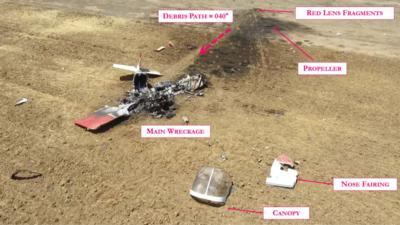Tue, Jul 06, 2021
Footage Revealed That The Airplane Made A Hard Right Bank, With The Wings Near Perpendicular
Location: Porterville, CA Accident Number: WPR21FA223
Date & Time: June 7, 2021, 14:20 Local Registration: N94PJ
Aircraft: Vans RV6 Injuries: 1 Fatal
Flight Conducted Under: Part 91: General aviation - Personal

On June 07, 2021, about 1420, a Vans RV-6A experimental airplane, N94PJ, was substantially damaged when it was involved in an accident in Porterville, California. The pilot was fatally injured. The airplane was operated as a Title 14 Code of Federal Regulations (CFR) Part 91 personal flight. The pilot departed from his home airport in Fresno, California about 1320 and landed at Porterville shortly thereafter.
Numerous witnesses at the airport observed the pilot refuel and takeoff. They stated that the pilot refueled the airplane with about 17.5 gallons at the self-serve fuel tanks located mid-field. A witness observed the pilot, positioned in the right seat, start the airplane after refueling. The start-up was abnormal and sounded as though it was a “hot start” with the airplane rpm’s immediately accelerating to a near maximum setting. The airplane then continued to the departure end of runway 04 and proceeded to takeoff. The airplane began to climb, and the engine was making “popping” sounds while continuing left of centerline. The nose pitched down, and the engine momentarily sounded normal as the airplane then climbed to about 300 ft above ground level (agl). The “popping sounds” continued and some witnesses observed that the engine then experienced a loss of power.
Video footage was obtained from a fixed security camera at the airport. A review of the footage revealed that the airplane made a hard right bank, with the wings near perpendicular to the ground, consistent with the pilot attempting to return to the airport. The witnesses further stated that the airplane then momentarily maneuvered to a wings-level attitude and then rolled left, akin to a snap roll. The airplane then rapidly descended in a left-wing low attitude nearly perpendicular to the terrain and immediately erupted into flames.
The accident site was located about 250 ft from the approach end of runway 12 on flat terrain composed of hard, dry dirt and short vegetation. The wreckage was found distributed over an approximate 40-foot distance with the nose pointed on a median magnetic bearing of about 350°. The fuselage and inboard sections of the wings had been consumed by fire. The first identified piece of debris was fragments of red lens, consistent with the tip of the left wing contacting the ground at the beginning of the accident sequence. From the lens fragments was pieces of propeller blades and pieces of the skin.
More News
"The owners envisioned something modern and distinctive, yet deeply meaningful. We collaborated closely to refine the flag design so it complemented the aircraft’s contours w>[...]
Nonradar Arrival An aircraft arriving at an airport without radar service or at an airport served by a radar facility and radar contact has not been established or has been termina>[...]
From 2022 (YouTube Edition): Still Life with Verve David Uhl was born into a family of engineers and artists—a backdrop conducive to his gleaning a keen appreciation for the >[...]
Also: Electra Goes Military, Miami Air Taxi, Hypersonics Lab, MagniX HeliStrom Amazon’s Prime Air drones are back in the spotlight after one of its newest MK30 delivery drone>[...]
Also: Trailblazing Aviator Betty Stewart, Wind Farm Scrutiny, Chatham Ban Overturned, Airbus Shares Dive A Thunderbird pilot, ID'ed alternately as Thunderbird 5 or Thunderbird 6, (>[...]
 Aero-News: Quote of the Day (12.11.25)
Aero-News: Quote of the Day (12.11.25) ANN's Daily Aero-Term (12.11.25): Nonradar Arrival
ANN's Daily Aero-Term (12.11.25): Nonradar Arrival Classic Aero-TV: David Uhl and the Lofty Art of Aircraft Portraiture
Classic Aero-TV: David Uhl and the Lofty Art of Aircraft Portraiture Airborne-NextGen 12.09.25: Amazon Crash, China Rocket Accident, UAV Black Hawk
Airborne-NextGen 12.09.25: Amazon Crash, China Rocket Accident, UAV Black Hawk Airborne 12.05.25: Thunderbird Ejects, Lost Air india 737, Dynon Update
Airborne 12.05.25: Thunderbird Ejects, Lost Air india 737, Dynon Update



